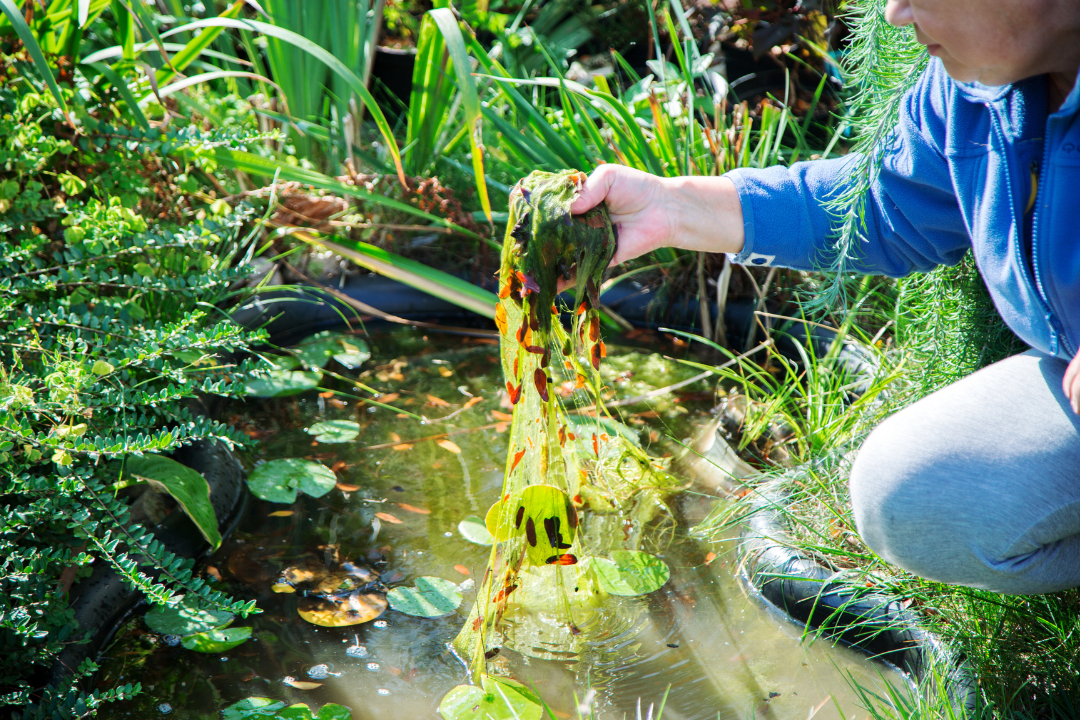If you’ve ever experienced algae in your pond, you’ll know only too well the problems it can cause (as well as from being unsightly). Algae in your pond can spread quickly and leave the pond with murky and pea-coloured water. If you’ve ever wondered how your pond has become infested with algae and what you can do about it, we’ve got it covered.
See how you can build a low-maintenance pond
What is pond algae?

All ponds are bound to experience algae at some stage. There are many different types of pond algae, including Spirogyra (or blanket weed). Blanket weed is a common alga that is mostly found in freshwater ponds.
Different types of algae can affect your pond differently. Some, such as blanket weeds, will grow suspended on the surface of the water making them easy to spot. Other algae, such as string algae, will grow in the pond water at the base or sides of the pond making it much more difficult to spot.
Unlike traditional plants with roots, algae have no leaves or roots. Instead, it spreads through spores. It can sometimes start forming in a small section of your pond but if left untreated, it can rapidly spread to cover the whole surface. That’s because suspended algae, such as blanket weed, is single-celled allowing for reproduction at a rapid rate.
The spores which are carried by wind, birds, insects, and amphibians, settle on the pond’s surface. When an imbalance occurs in the pond, the spores start to grow. An imbalance in your pond can occur when there’s a high mineral content (usually through poor pond maintenance) in the water. High mineral content can occur from:
- Organic matter
- Fertilisers seeping into the water
- Fish faeces
- Fallen leaves
- Using tap water instead of rainwater
- Acidic water levels
Providing the correct circumstances arise, blanket weed will start to grow when exposed to sunlight. Ponds that are directly in sunlight will face a much greater problem compared to those in the shade. Algae grows through photosynthesis, and so direct exposure to sunlight gives the algae food to grow (providing there are enough nutrients in the water).
How does blanket weed affect your pond?

Algae that have a dense growth, such as blanket weed, can damage the ecosystem of your pond. Algae will most commonly grow in the Spring as the weather conditions start to improve while your pond remains at a low temperature.
The lower pond temperatures in the Spring will leave most of your pond’s life (such as fish and aquatic plants) inactive. As the algae are the only major contributor to the pond’s ecosystem, there’s no competition for vital food sources helping the algae to thrive.
As well as being unsightly, algae aren’t any good for your pond. If you keep fish and other aquatic life in a pond, the algae will be depriving them of sunlight and oxygen. Algae consumes a lot of oxygen leaving little left for fish and aquatic plants.
When oxygen levels are lower in the summer, your current pond’s ecosystem could be greatly affected. Increased competition for oxygen in your pond can leave aquatic plants to die and fish to suffer from met hypoxia. In extreme circumstances, hypoxia can cause the fish to die.
Pond algae is an unwelcome guest in anyone’s pond, and the sooner it starts to materialise, the quicker you need to act. But what can do about it?
What can you do about it?

Trying to remove pond algae can be a big problem. The simple solution many people think of is to simply scoop the algae from the surface. This only acts as a short-term solution as the algae will strike back with a vengeance. The sooner you act, however, the better. Algae can be very problematic to get rid of in large amounts.
Removing the algae in this manner will cause the algae to release spores into the water leaving you in the same boat as before. Instead, if you intend to remove the algae using a net, you need to kill it first to prevent the release of spores.
The best option you have to prevent future outbreaks of algae is to disturb the equilibrium of your pond. While other methods, such as using barley straw, may seem like a good idea, they only help to eradicate the problem in isolated incidents. For a more permanent solution, consider a blanket weed controller.
Providing some shade can help minimise the sunlight exposure that is likely to affect algae growth. Adding some pond foliage can also help protect fish, such as Koi, from predators.
Using a blanket weed controller
Algae growth, and the simple cell structure, are dependent on the calcium forms within the water. A blanket weed controller works by disturbing the balance required for the algae growth by emitting a low-frequency magnetic field.
The frequency emitted from the blanket weed controller seeks to disturb the balance required for the blanket weed metabolism. The signal emitted from the blanket weed controller encourages a sudden and rapid growth spurt that causes the weed to die.
Compared to other treatments available, a blanket weed controller doesn’t add any additional chemicals to your pond. The signal that disturbs blanket weed growth also doesn’t affect any other pond plants or life, so it’s safe to use with other aquatic life in your pond.
By installing a blanket weed controller to your pond, you can also benefit from:
- A low-cost solution
- Helps maintain the appearance of your pond
- Sustains a healthy ecosystem
- Permanent solution to eliminating algae
- Easy to install with no moving parts or need for regular maintenance
- Helps keep any pipes, pumps, or filters free from algae
- Fit and forget
Installing the blanket weed controller is simple. For it to work effectively, it should be fitted between your pond’s pump and filter. No additional plumbing is required as the device can fit around your existing piping.
With the problems that algae and blanket weed can cause, trying to find an effective solution to help sustain a healthy and balanced ecosystem can be difficult. Whilst you may be tempted to try other solutions, these may only act as temporary or short-term solutions. A blanket weed controller will help you to eradicate the problem permanently. Once it’s installed, you can leave it to work its magic!
FROM: Aaron Middleton
Learn More: How to Get Rid of Algae in Fish Tank


Comments (0)
Back to Pond